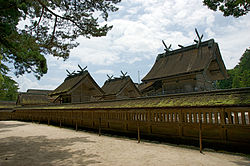| Hawaii Izumo Taisha ハワイ出雲大社 | |
|---|---|
 | |
| Religion | |
| Affiliation | Shinto |
| Deity | Ōkuninushi, Hawaii Ubusuna-no-Kami |
| Leadership | Bishop Daiya Amano Rev. Jun Miyasaka |
| Location | |
| Location | 215 N Kukui St, Honolulu, HI 96817 |
| Coordinates | 21°18′55.984″N157°51′39.682″W / 21.31555111°N 157.86102278°W |
| Architecture | |
| Style | Taisha-zukuri |
| Established | 1906 |
| Website | |
| www | |
The Izumo Taishakyo Mission is a Shinto shrine located in downtown Honolulu, Hawaii. It is one of the few active Shinto shrines in the United States. The wooden A-frame structure was inspired by Shimane Prefecture's classical Japanese shrine Izumo-taisha. It was designed by architect Hego Fuchino and built by master carpenter Ichisaburo Takata.
Contents
The primary kami of this shrine is Ōkuninushi and Hawaii Ubusuna-no-Kami. Also enshrined are Okinawa Shrine, Naminoue Shrine, Futenma Shrine, Inari Shrine, and Ebisu Shrine, and Waianae Ujigami. [1]
The shrine is the site of the annual New Year's Day hatsumōde as well as other events throughout the year. A replica of the Hiroshima Peace Bell is on view. The annual Hiroshima Commemoration and Peace Service is held at Hawaii Izumo Taisha to commemorate the atomic bombing of Hiroshima. [2]


